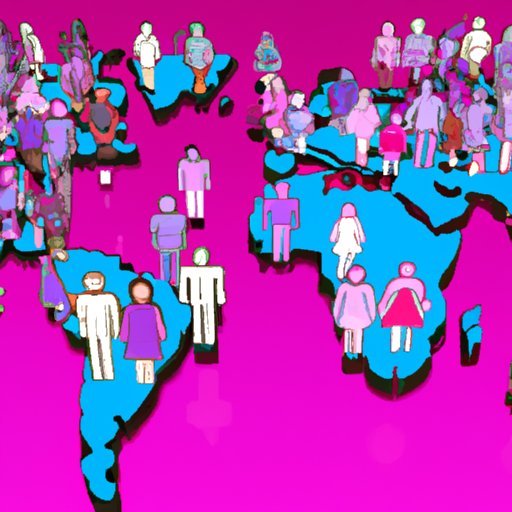Introduction
The issue of gender imbalance has been a hot topic of discussion in recent years, with many countries around the world striving to create an equitable society where both men and women have equal rights and opportunities. To understand the implications of this imbalance, it is important to take a closer look at the global population by sex and examine how many men and women are in the world today.

Exploring the Gender Balance: A Study of Global Population by Sex
The world’s population is estimated to be over 7 billion people, and the male-to-female ratio is roughly equal. However, there are some regional variations in terms of gender distribution. For example, in some parts of Asia and North Africa, the number of males is higher than females. This is due to a variety of factors, such as cultural norms which favor sons over daughters, high rates of female mortality in childbirth, and gender-selective abortions.

An Analysis of Global Gender Distribution and its Implications
The impact of gender on economic development is significant. Studies have shown that when women participate in the workforce and are given equal access to education, health care, and other resources, economic growth is accelerated. Furthermore, when women are able to make their own decisions about marriage and family planning, it can help reduce poverty and improve overall well-being.
Gender-based discrimination and inequality are also common in many parts of the world. In many countries, women are denied basic human rights, such as the right to vote or the right to own property. Additionally, women often face gender-based violence, such as rape, domestic abuse, and sexual harassment.
A Look at the Male-to-Female Ratio in the World Today
When looking at the male-to-female ratio by country, it is clear that there are significant variations from one region to another. For example, in India, the male-to-female ratio is 1.06, while in South Africa it is 0.92. Similarly, in China the ratio is 1.17 while in the United States it is 0.97.
In addition to these differences between countries, there are also regional differences in gender ratios. For example, in the Middle East and North Africa, the male-to-female ratio is much higher than the global average, while in Europe and North America the ratio is lower than the global average.
The Demographics of Gender: How Many Men and Women are in the World?
According to the most recent estimates, there are approximately 3.5 billion women and 3.5 billion men in the world today. The total population is divided roughly equally between the two sexes, with women making up slightly more than half of the global population (50.8%).
When looking at age groups, the ratio of men to women generally decreases with age. For example, among children aged 0-14, the ratio of males to females is 1.05, while among adults aged 15-64, the ratio is 0.99. The ratio then increases again among the elderly, with those aged 65 and over having a ratio of 1.15.
Understanding the Gender Divide: Investigating Worldwide Sex Ratios
The worldwide sex ratio has implications for society in terms of economic development, gender-based discrimination, and social dynamics. It is important to understand the implications of this divide in order to create policies and initiatives that promote gender equality and empower women.
Progress towards equality has been made in recent years, with many countries passing laws to protect women’s rights and providing access to education and healthcare. However, much more needs to be done to ensure that men and women have equal opportunities and access to resources.
Conclusion
This article has explored the gender balance in the world today, including a look at the male-to-female ratio and regional differences in gender ratios. It has also examined the implications of gender on economic development, gender-based discrimination and inequality, and progress towards equality.
Overall, the data shows that there are approximately 3.5 billion men and 3.5 billion women in the world today, with women making up slightly more than half of the global population. Despite progress towards gender equality, there remains a large gender divide in terms of access to resources, economic opportunities, and social dynamics.
It is important to continue to strive for gender equality and empower women around the world in order to create a fairer and more equitable society for all.


